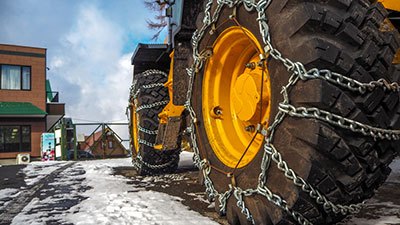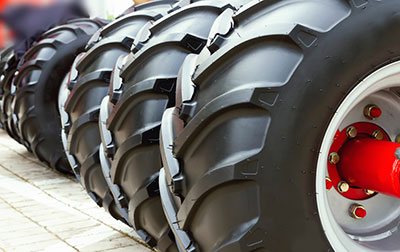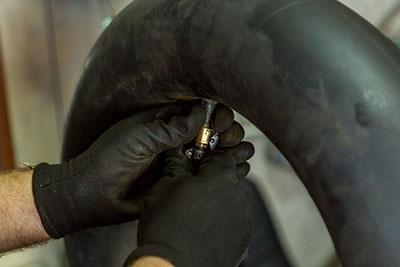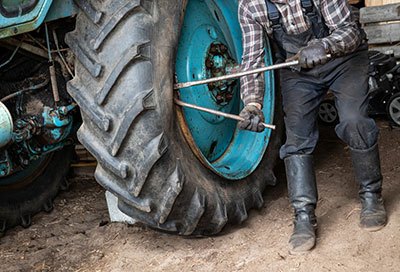Tractor tires are a critical piece of equipment for farmers and ranchers who rely on the productivity of their tractors to move materials, plow fields, or haul loads.
And while tubed tires have been the standard for generations, tubeless tires are now gaining in popularity due to their inherent benefits. But what exactly are these differences?
What does each type bring to your operation as far as operational efficiency, lifespan, and cost?
We’ll be taking an honest look at both types of tractor tires today – highlighting the pros and cons of each – to help you decide which setup is right for you.
Take away key points:
- Tubeless tires have a thicker sidewall, which helps reduce air leaks in the event of a puncture, which adds more puncture protection.
- Tube-type tires are easier to install with regular tools, making them more affordable and ideal for many applications.
- Tubeless tires offer superior grip and performance but require special equipment for installation and use.
- Ultimately the choice between a tubeless or tubed tire should be based on the specific needs of the user.
- Tubeless tires were invented back in 1970, while today you can find them on nearly all farm machinery!
- The excellent heat emission of tubeless tractor tires is a major selling point.
Table of Contents
- Differentiating between tubeless and tube type wheels
- Things to consider when choosing a tubeless vs a tube type tire for your tractor
- Advantages of tubeless tires
- Disadvantages of tubeless tires
- Advantages of tube-type tires
- Disadvantages of tube type tires
- The cost factor: Is it worth it to invest in a tubeless vs. tube type tractor tire?
- Tips on tire maintainance
- How to install tubeless tires?
- FAQs
- Final words
Differentiating between tubeless and tube type wheels

Tube-type tires are the standard for tractors, but tubeless tires are becoming more popular as they provide higher levels of traction and lower rolling resistance.
To understand the differences between these two types of tires, it’s important to explore the construction of each tire and how they support the tractor.
Tubed tires are constructed with a thick inner tube filled with air that supports the tire bead on one side and then an outer tire casing that is filled with treads. A tire bead can easily identify tubed or tubeless tires.
For the former, a distinguishing mark will be present along its circumference that may even reach up to the sidewall. The latter, however, will just have a faint line in comparison.
This allows for greater maneuverability and versatility on all surfaces since the tread provides a better grip.
They also provide superior shock absorption due to their thicker rubber profiles. The downside is that because they require an inner tube, they can be subjected to punctures and cause flat spots easier than tubeless tires.If your deflated tubeless tire has gone completely flat, you’ll have to lift the tractor in order to reset the tire bead seal and properly re-inflate it.
Tubeless tractor tire is constructed without an inner tube so there is no risk of getting punctured or flat spots. It’s important to point out that tire manufacturers developed tubeless tires in the 1970s, and today almost all agricultural equipment uses them. The type of tire your tractor utilizes must be determined, and doing so is a straightforward process.
They also tend to provide better traction due to their increased contact area with the ground; this makes them ideal for off-road environments where extra grip is needed. Once you get a puncture, the liner prevents air pressure form decreasing rapidly. Instead, you will get a slow leak unlike a tube tire which deflates faster.
However, a tubeless tractor tire does lack some of the shock-absorbing capacity that tubed tires offer, which means you may not get as comfortable a ride compared to tube-style tires.
Things to consider when choosing a tubeless vs a tube type tire for your tractor
When choosing between a tubeless tractor tire and a tubed tires, there are several features to consider.
Firstly, you should evaluate the kind of terrain and surface on which the tractor will be used.
Tubeless tractor tires provide better traction on loose surfaces, while tube-type tires are better suited for hard surfaces or roads.
You should also weigh up cost versus performance when selecting a tire type.
Tubeless tires can often be more expensive than their tube-type counterparts, yet also offer better traction and overall performance.
Additionally, consider any extra maintenance requirements associated with each type of tire, as well as whether or not you need a spare inner tube in case of puncture repair.
Finally, you should take the comfortability of each type of tractor tire – tubeless tractor tires typically provide less shock absorption than those using an inner tube.
Advantages of tubeless tires

Tubeless tractor tires offer some distinct advantages over tubed tire type when it comes to your tractor.
First, they have a better grip than traditional inner tube tires because they have more contact with the ground. This makes them ideal for use on off-road terrains and other challenging surfaces.
They also come with the added benefit of having no risk of puncture or flat spots since there’s no inner tube to be damaged. Additionally, due to the better heat emission, tubeless tires have a much slower air leaks.
Also, a tubeless tire can hold air for longer, which gives you more options for keeping your tire pressure at the right level and ensuring you get better performance. Lastly, the tubeless tire has a reduced rolling resistance which helps improve fuel efficiency and save costs in the long run.
Disadvantages of tubeless tires
There are some good things about tubeless tires, but there are also some bad things about them.
First of all, they are often more expensive than their tube-type counterparts because they are made with more materials and require more work.
Also, tubeless tires can be harder to install and maintain than tires with tubes. You usually need more specialized tools, which can add to the cost of working on your tractor.
Another problem with a tubeless tire is that many tires of this type make more noise on the road than their tube-type counterparts.
Lastly, a tubeless tire doesn’t have an inner tube, so if it gets a hole, the whole tire needs to be replaced, not just the inner tube. But tubeless tires are also easily fixed with a tire plug or a tire sealant.
Advantages of tube-type tires

Tires with tubes are better in a number of ways than tires without tubes.
First of all, they are usually less expensive because they are easier to build and make. Also, tube-type tires can be easier to fix if they get a hole. Often, all you have to do is replace the inner tube to get back on the road.
Also, tube-type tires tend to make less noise on the road, which makes them great for people who want a quieter ride.
Lastly, since there is more rubber on the ground than with tubeless tires, they often have a better grip when it is wet.
Disadvantages of tube type tires
The main problem with tube-type tires is that the inner tube is more likely to get a hole because it is exposed to sharp objects and debris.
Also, if you get a puncture or a flat tire, it’s hard to use a tire sealant to seal the hole so that air doesn’t leak out. Most of the time, you’ll need to replace the whole tire, not just the inner tube, but be sure to do it quickly or otherwise, you are in for immediate tire failure.
Another problem is that they take longer to inflate because both the tire and the inner tube need to be filled with air.
Lastly, because they are more difficult to make, they can be more expensive than tubeless tires because more materials and work go into making them.
The cost factor: Is it worth it to invest in a tubeless vs. tube type tractor tire?
When deciding between tubeless and tube-type tractor tires, the cost is always a factor.
In general, a tubeless tire tend to be more expensive than their tube-type counterparts due to the increased complexity of the design and manufacturing processes.
But compared to the cost of frequent repairs or a new tire caused by punctures in tube-type tires, the long-term cost savings may justify the initial investment in a tubeless tire.
Overall, it’s important to consider all factors – from your budget and usage to terrain and climate – when deciding which type of tire is right for you. The cost difference between tubeless tire and tube-type tractor tires should not be taken into account as the only factor when making this decision.
Tips on tire maintainance
Here are some tips for maintaining both tire types-tubeless and tube-type tractor tires:
– Ensure the tire pressure is correct, as too much or too little can cause excessive wear.
– Check for any signs of damage or wear to the treads regularly.
– Rotate the tires every 6 months to ensure even tire wear.
– Have a professional inspect the tires annually for any signs of damage or wear.
– Clean your tires with a mild soap and water solution regularly to prevent debris buildup.
How to install tubeless tires?

Here are the basic steps for installing tubeless tires so you can avoid bad assembly and ensure long service life:
– Remove the old tire from the wheel by deflating it and using tire irons to break the bead and get it off the rim.
– Start installing the new tire by inserting the valve stem and lining up the bead with the rim edge.
– Use a mounting lubricant or soapy water to help slide the tire onto the rim, being careful not to damage the tire or rim
– Once the tire is on the tire rim, use an air pressure compressor to inflate the tire until the beads seat on the rim.
– Check the tire pressure and inflate it to the manufacturer’s recommended pressure.
– Use a torque wrench to tighten the valve stem nut and the lug nuts to the manufacturer’s specifications.
– Finally, make sure to test the tire for air leaks by spraying soapy water onto the surface of the tire and looking for bubbles.
FAQs
What is the difference between tube and tubeless tractor tires?
Tubeless tractor tires seal differently than tube tires.
Tube tires need to be filled with air, making them more susceptible to punctures from sharp objects and debris on the ground. Due to its airtight seal, tubeless tires don’t need inner tubes while the liner leaks air more slowly.
Which is better tube type or tubeless?
Budget, terrain, and climate determine your tire kind. Tube tires are cheaper but more puncture-prone due to their inner tubes. While heavier and more costly, tubeless tires perform better on difficult terrain.
Should I put tube in tractor tire?
Generally speaking, it is recommended to use a tube for tubed tire tractor tires. The inner tube must be properly inflated for the tire to work well and last as long as possible.
Are lawn tractor tires tubeless?
While some lawn tractor tires are available in both tube type and tubeless, most are tubed due to their affordability and ease of installation.
Tube type lawn tractor tires have an inner tube that must be inflated properly for optimal performance.
Can you run a tube-type tractor tire tubeless?
While it is possible to run a tube type tractor tire tubeless, it is not recommended due to the increased risk of puncture and blowout.
Tubeless tires have better grip and performance, but they have to be installed and used with special tools.
How to tell if tractor tire is tubeless?
Tubeless tractor tires are easy to identify because they have a thicker sidewall than tube-type tires. If a tubeless tire gets a hole, the sidewall is made to keep air from leaking out.
In addition, tubeless tires will often have an embossed image of a circle with a cross on it, indicating that the tire is specifically designated for tubeless use.
Final words
In conclusion, when it comes to tractor tires, there is a clear difference between tubeless and tube type tires.
Tubeless tires offer superior grip and performance but require special equipment for installation and use.
Tube type tires are easier to install with regular tools, making them more affordable and ideal for many applications.
Ultimately the choice between tubeless or tube-type tractor tires should be based on the specific needs of the user.
